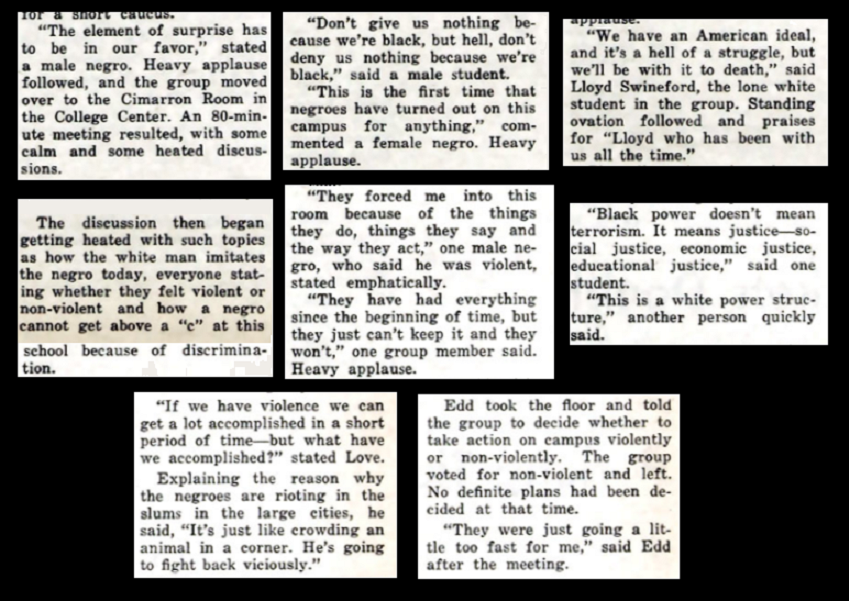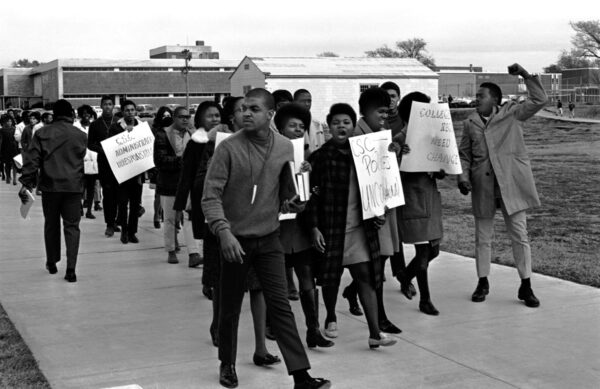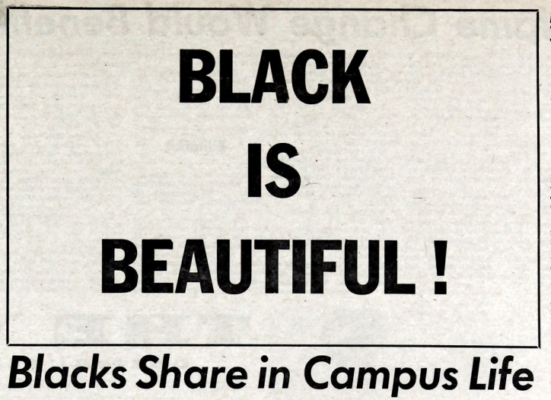Ongoing Discrimination and the End of an All-White Edmond
Despite the progress made at Central State College, Edmond itself still remained completely white until 1968, which signified a change in race relations in Edmond. In April of that year, Martin Luther King Jr. was assassinated in Memphis, Tennessee, sparking riots across the country. In memoriam of Dr. King, Central State College held a service in the chapel and broadcast it into the student union. However, someone in the student union began to play an upbeat, happy song on the jukebox, and a fight nearly broke out in an attempt to turn the music off. In addition, classes were not let out that day.
Feeling that the university did not do enough to honor King’s legacy, about 70 African American students marched on President Garland Godfrey’s office. However, he was not there so the protesters moved outside to the flag pole in front of the administration building and began a rally and discussion. Tensions were high, with the main topic of discussion being whether or not they should resort to violence to get their point across. The protesters voted and decided that non-violence was the path to pursue.

Mentioned in the final paragraphs, Leon Edd was the president of Kappa Alpha Psi, and he, along with fellow student, Maurice Love, helped to calm the heated demonstration down.
Recognizing the need for organization and representation on campus, students created the African American Student Union in May of that year. However, racial tensions would heat up again later in the year centered around two incidents that occurred on campus in November 1968.
The first was a fight that occurred in the student dining area between several African Americans and white students. One white student and one African American student were suspended for 30 days. The African American student ended up suffering some cuts to his face and losing some teeth in the fight. Not long after that, an undescribed “disturbance,” occurred in the girls’ dormitory. Two African American girls, Guin Greene and Mattie Multer, were suspended. The girls’ filed an appeal, but the court held up the college’s decision.
Outrage soon followed as the college was accused of racial discrimination for issuing harsh punishments and not providing the students with proper legal recourse. Several students of the African American Student Union submitted a list of demands to President Godfrey and protested peacefully in the administration building. These actions were not officially endorsed by the Union itself. Godfrey fired back with a piece in the November 14, 1968 edition of The Vista in which he stated that the punishments given were actually more lenient than what similar cases received and that he acted in accordance with all laws, policies, and procedures.

The lasting legacy of these incidents, however, was opening the college and the city of Edmond to criticism and investigation into allegations and cases of discrimination. The incident in the dorm room highlighted that all of the African American students were housed on the same floor and that there were no cases of integrated dorm rooms, a violation of the 1964 Civil Rights Act. This revelation sparked an investigation into the college by the US Department of Health, Education, and Welfare (HEW) at the request of the NAACP.
In February of 1970, Central State College celebrated its first Black Heritage Week. A week-long celebration of Black culture and achievements centered around the theme of Black awareness, that featured various entertainers and speakers and was sponsored by the Black Greek organizations on campus.


Mentioned above, Eldrige Cleaver was a high-ranking member of the militant Black Panther party at the time. Cleaver would later part ways with the organization for not being radical enough. In the 1980s he ended up joining the Church of Latter-Day Saints and became a conservative Republican.
Black Heritage week also spawned Central’s Miss Black Central State College pageant, and the school newspaper began publishing editorials about what it was like to be Black in Oklahoma at the time. In addition, Central State College also started offering discussions and seminars about race in America. Throughout the 1970s, the college began hiring more and more African American teachers and offering more classes centered around African American history and culture.
In the 1970s Frank Finney was the dean of the Liberal Arts Department and according to Dr. Paul Lehman, Finney really was passionate about ending the discrimination on campus.
“Dean Finney took that challenge seriously. I would say unequivocally had it not been for his concern and his efforts the few African Americans that are in the College of Liberal Arts would not be here had it not been for him.”
Dr. Paul Lehman, when asked about how the campus hired more African American faculty as quoted in a University of Central Oklahoma sponsored oral history interview on February 20th, 2006.
Lehman also taught the first courses on AfricanAmerican history on campus in 1971. Lehman also fought hard to introduce an Ethnic American Literature course, but was turned down multiple times. In 1984, Lehman tried to run for Department Chair Person. Others in the department did not like the idea of having an African American person representing them. Opponents to Lehman fought hard against him, and he was ultimately defeated in the election for Department Chair Person. Lehman stated in a 2006 interview that Dean Finney had tears in his eyes as he announced the results and ended by stating that, “This is the most blatant display of racism I have ever witnessed.” Although Lehman did not get the position, he did become the Graduate Dean, which gave him the ability to get the Ethnic Literature course approved.
Since African American families slowly began moving back to Edmond in the late 1970s, Edmond’s population has become more diverse. As of 2021, non-white residents account for approximately 20% of the population in Edmond. While this has certainly increased in the last four decades, it is still slightly less than the percentage of non-whites in all of Oklahoma (25%). 5.3% of Edmond residents identified as “Black or African American alone” compared to 7.8% in all of Oklahoma.
Edmond’s history includes the reputation of being unwelcoming to people of color and a haven for people who would relocate before being required by law to integrate. While the population here still identifies itself as predominantly white, Edmond has slowly grown into a more diverse community in the decades since the explosive growth of the 1960s and 1970s. Our more recent history includes an awareness of our segregated past and a commitment to creating a more inclusive and diverse community.
